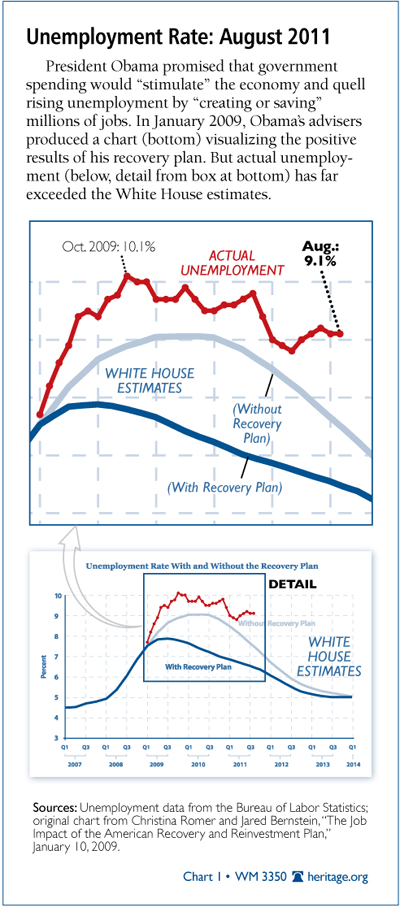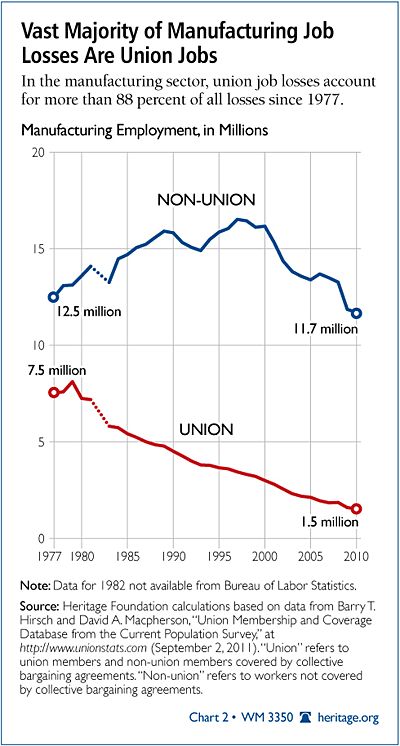The Bureau of Labor Statistics (BLS) reported that in August, United States employers added no net new jobs, and the unemployment rate stayed the same at 9.1 percent. Overall, the private sector added 17,000 jobs, but that was totally offset by declines in public-sector employment. This troubling report also contains downward revisions to previous jobs estimates this year and declines in other measures of labor utilization, such as the number of hours worked.
Everyone who cares about the future of this economy will spend some of their Labor Day weekend asking why it is that this great engine of prosperity has now apparently ground to a near standstill. The answer, however, is increasingly clear: New government regulations and massive growth of unproductive government programs have made it harder for the labor market to recover.
The August Report
In August, the labor market did not create or lose any additional jobs. However, BLS estimates that the Verizon strike temporarily reduced employment in the communications industry by 45,000 jobs. Overall, the rate of job creation has continually eroded for the past several months. Furthermore, BLS revised downward job estimates of previous months by 58,000.

The household survey for August did not report a change in the unemployment rate.[1] The household survey also reported an increase in the labor force participation rate, with 366,000 more adults in the labor force. Most of the new workers reported that they had jobs, which is why the unemployment rate remained the same despite growth in the labor force. It is likely that this relative good news is a correction to the previous month’s report, which showed a startling decline in the labor force and number of employed workers.
The payroll survey’s analysis is very troubling, as there are indications that the labor market’s stall may be turning into a slight decline. Manufacturing employment (–3,000) and construction (–5,000) both declined in August. The service sector (20,000) had some job growth but mainly in health care and social assistance (35,500). The bright spot in the payroll report was a slight uptick in temporary workers (4,700).
Other signals of labor market demand declined, with the average number of weekly hours falling from 34.3 to 34.2. Average hourly earnings also showed an alarming decline by 3 cents, which reduced the average weekly earnings for existing workers.[2] In short, jobs are not being created, and existing workers earned less last month.
Unions Reduce Job Growth
Despite the weak economy, the Administration has put the task of satisfying interest groups above job growth. The latest example comes from the federal government’s National Labor Relations Board (NLRB), which issued several rulings recently undermining employer and employee rights.
Unions make businesses less competitive and discourage investment. This reduces job growth. Studies show that jobs fall by 5–10 percent at newly organized firms.[3] Going forward, employment grows by three to four percentage points more slowly at unionized businesses than at otherwise identical non-union companies.[4]
This can significantly affect employment. For example, unionized manufacturing employment fell by 80 percent between 1977 and 2010. Non-union manufacturing employment decreased by 6 percent over that same time period. In the aggregate, almost all net manufacturing job losses have come from unionized companies.

If private-sector workers feel they need a union for protection, they have that right. Management gets the union it deserves. But if workers do not want a union, the government should not make that choice difficult. The economy performs better when unions organize only those companies with employees who believe they need them.
Unions Lobby Government to Reverse Their Decline
This truth directly conflicts with the desires of the union movement. Surveys show that only one in 10 unorganized workers want a union.[5] The labor movement has failed to persuade workers that union representation would improve their workplaces. As a result, private-sector union membership has fallen below 7 percent.[6]
The union movement wants the government to reverse their decline by making it harder for workers to remain non-union. Unions lobbied Congress and the Administration to replace secret ballot organizing elections with publicly signed cards.[7] This legislation failed. The union movement now wants the government to unionize through regulation.
Snap Elections. The Obama NLRB complied. Obama’s appointees have begun rulemaking to dramatically shorten the timeframe for union elections. Employers are often unaware that an organizing drive is taking place until after the union calls for a vote. Currently the median election takes place about a month after the union calls for it.[8] That time gives employers a chance to present their side and inform workers of the downsides of unionizing that organizers avoided mentioning.[9] Having heard both sides, employees make an informed choice.
The NLRB proposes to shorten the election period to as little as 10 calendar days.[10] Such snap elections would deny employers the time needed to make their case and ensure that workers vote having heard primarily arguments for unionizing.
No Secret Ballot. Federal law does not guarantee workers a secret ballot before their company unionizes. An employer may voluntarily recognize a union if a majority of its workers publicly sign union authorization cards (i.e., card-check). Some unions have enough leverage to pressure employers to accept card-check. However, the law gave employees an important protection: If a company recognized a union without a vote, employees could petition for a secret ballot election to decertify the union.
The NLRB just removed this safeguard.[11] Now employees cannot file for a vote for six months to a year after card-check recognition. If by that point the union has negotiated a contract, the employees cannot vote until the contract expires. Workers whom organizers pressured into signing a card can no longer privately vote against union representation.
Cherry-Picking Voters. The NLRB used to define a collective bargaining unit as all similarly situated workers at a company. For example, at a retail store, hourly employees like the cashiers, shelf-stockers, and greeters would traditionally form one unit. The NLRB just changed this rule to permit unions to cherry-pick which workers to include in the bargaining unit.[12] For example, unions could organize just the cashiers and exclude the shelf-stockers. Only the union’s desired workers would get to vote. However, a strike or union-induced bankruptcy harms all the workers at a company. The new NLRB rules effectively disenfranchise employees who do not want their company unionized.
The President has put satisfying unions above reducing unemployment.
Choosing Unions over Employers
Worrying about the labor market’s slow recovery has changed into worrying about the labor market declining. Projections of future employment growth by both government and private forecasters have been downgraded in the past few months. The President’s forecasting body, the Office and Management and Budget, revised its projected unemployment rate in the week before Labor Day.
In this report, there are more signs of a declining labor market than there are of a recovery. However, the President’s Administration is making it tougher for businesses to expand and hire new workers. Many decisions by the NLRB will reduce the demand for labor and keep businesses from expanding and hiring new workers. Policymakers in Washington should seek to help businesses and the labor market instead of viewing businesses as the enemy.
Rea S. Hederman Jr. is Assistant Director of and Research Fellow in the Center for Data Analysis, and James Sherk is Senior Policy Analyst in Labor Economics in the CDA, at The Heritage Foundation.


